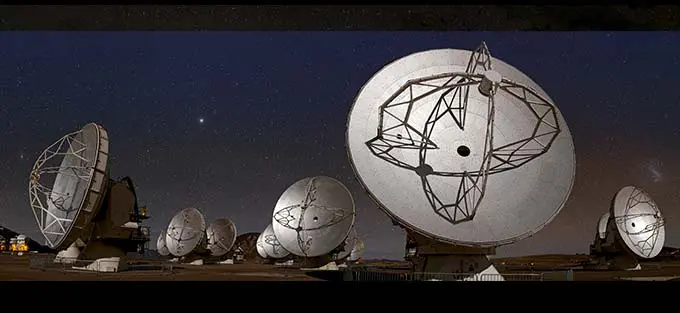ALMA Sets Development Objectives for the Next Decade
After half a decade of ALMA operations, the original science goals of the observatory have been essentially met. To maintain the leading-edge capabilities of the observatory, the ALMA Board designated a Working Group to prioritize recommendations from the ALMA Science Advisory Committee (ASAC) on new developments for the observatory between now and 2030.
The Working Group concluded, based on the ASAC recommendations, that the science drivers that will support further developments shall be:
- to trace the cosmic evolution of key elements from the first galaxies through the peak of star formation in the Universe;
- to trace the evolution from simple to complex organic molecules through the process of star and planet formation down to solar system scales;
- to image protoplanetary disks in nearby star formation regions to resolve their Earth-forming zones, enabling detection of the tidal gaps and inner holes created by forming planets.
Even with the outstanding capabilities of the current ALMA array, achieving these ambitious goals is currently impossible. The ALMA observatory needs to become more powerful to address these new challenges and stay at the forefront of astronomy by continuing to produce transformational science and enabling fundamental understanding of the Universe for the decades to come.
The top priority upgrades for ALMA will be focused on the receivers (the signal detectors), the digital systems (data transmission), and the correlator (the supercomputer data processor at the heart of the telescope).In addition, to keep up with the new powerful capabilities of the observatory, the ALMA Archive will be further developed, becoming the primary source for the ever-increasing number of publications using advanced data mining tools.
The recently appointed ALMA Director, Sean Dougherty, is very enthusiastic about these new developments being implemented in the coming years, as "they will ensure a front-row seat for ALMA over the next decade, through the development of state of the art technology that will advance our understanding of the Universe. This is an important step in continuing the quest for our cosmic origins".
The proposed developments will advance a wide range of scientific studies by significantly reducing the time required for the complex observations required by the astronomical community to achieve its ambitious science goals.
“This is an exciting moment in the history of ALMA – says Toshikazu Onishi, Chair of the ALMA Board – as we are advancing the future capabilities of this extraordinary facility we built to explore the Universe.".
Link
Contacts
-
Nicolás Lira
Education and Public Outreach CoordinatorJoint ALMA Observatory, Santiago - ChilePhone: +56 2 2467 6519Cel: +56 9 9445 7726Email: [email protected]


